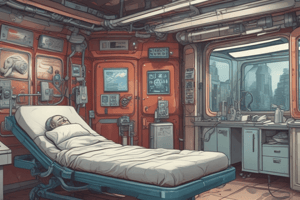Podcast
Questions and Answers
What is the MOST compelling reason to disagree with a patient's refusal of transport after a seizure?
What is the MOST compelling reason to disagree with a patient's refusal of transport after a seizure?
- He is conscious and answering questions
- He has a history of seizures
- He is currently not prescribed any medications (correct)
- He is 30 years old
A patient who is possibly experiencing a stroke is eligible for thrombolytic therapy if he has bleeding within the brain.
A patient who is possibly experiencing a stroke is eligible for thrombolytic therapy if he has bleeding within the brain.
False (B)
What condition is characterized by slurred and difficult-to-understand speech?
What condition is characterized by slurred and difficult-to-understand speech?
dysarthria
How is a patient with an altered mental status characterized?
How is a patient with an altered mental status characterized?
What should you ensure during the primary assessment of a semiconscious patient?
What should you ensure during the primary assessment of a semiconscious patient?
Interruption of cerebral blood flow may result from cerebral vasodilation.
Interruption of cerebral blood flow may result from cerebral vasodilation.
Which side of the body is controlled by the left cerebral hemisphere?
Which side of the body is controlled by the left cerebral hemisphere?
What is the MOST significant risk factor for a hemorrhagic stroke?
What is the MOST significant risk factor for a hemorrhagic stroke?
What are the three major parts of the brain?
What are the three major parts of the brain?
What should you do when assessing for arm drift in a suspected stroke patient?
What should you do when assessing for arm drift in a suspected stroke patient?
What are you MOST alert for when caring for a patient with documented hypoglycemia?
What are you MOST alert for when caring for a patient with documented hypoglycemia?
What is the MOST important information to determine from the family of a suspected stroke patient?
What is the MOST important information to determine from the family of a suspected stroke patient?
Which condition is LEAST likely to mimic the signs and symptoms of a stroke?
Which condition is LEAST likely to mimic the signs and symptoms of a stroke?
Which condition MOST likely affects the entire brain?
Which condition MOST likely affects the entire brain?
How would you describe a simple partial seizure?
How would you describe a simple partial seizure?
What will the patient experience during the postictal state following a seizure?
What will the patient experience during the postictal state following a seizure?
What symptom would indicate that a patient's headache is caused by sinus congestion?
What symptom would indicate that a patient's headache is caused by sinus congestion?
What should treatment include for a patient with sudden onset of left-sided paralysis and slurred speech?
What should treatment include for a patient with sudden onset of left-sided paralysis and slurred speech?
What should you do for a child who is having a seizure with a high fever?
What should you do for a child who is having a seizure with a high fever?
What is the Glasgow Coma Scale (GCS) score for a patient who opens his eyes, moans, and pulls away when you pinch his trapezius muscle?
What is the Glasgow Coma Scale (GCS) score for a patient who opens his eyes, moans, and pulls away when you pinch his trapezius muscle?
What characterizes a generalized (tonic-clonic) seizure?
What characterizes a generalized (tonic-clonic) seizure?
Match the following parts of the brain with their functions:
Match the following parts of the brain with their functions:
The brain is most sensitive to changes in ______, ______, and ______ levels.
The brain is most sensitive to changes in ______, ______, and ______ levels.
What are the most common types of headaches?
What are the most common types of headaches?
Flashcards are hidden until you start studying
Study Notes
Neurological Emergencies
- Generalized seizures may leave patients conscious and refusing transport; consider medication history for transport necessity.
- Eligibility for thrombolytic therapy in stroke victims excludes those with bleeding in the brain.
- Dysarthria presents as slurred, difficult-to-understand speech.
- Altered mental status indicates a lack of clear thinking or arousability.
- In primary assessment, focus on ensuring a patent airway and supporting ventilation in semiconscious patients.
- Interruption of cerebral blood flow is not caused by cerebral vasodilation.
- The left cerebral hemisphere controls motor functions on the right side of the body.
- Major risk factor for hemorrhagic strokes is hypertension.
- The brain comprises three major parts: the cerebrum, cerebellum, and brain stem.
- Assess arm drift in suspected stroke patients by having them close their eyes.
- Be vigilant for seizures in patients with documented hypoglycemia.
- Establish the last time a suspected stroke patient appeared normal during medical history gathering.
- Hypovolemia is least likely to mimic stroke symptoms.
- Respiratory failure or cardiopulmonary arrest affects the entire brain.
- Simple partial seizures initiate from one extremity.
- Postictal states post-seizure often result in confusion and fatigue.
- Sinus congestion headaches worsen with bending over.
- Management of sudden onset left-sided paralysis and slurred speech includes placing the patient in recovery position and transporting.
- For a child with a febrile seizure, transport to the hospital while reassuring the mother.
- A Glasgow Coma Scale score of 8 indicates a patient who opens eyes, moans, and pulls away from stimuli.
- Generalized seizures cause severe twitching of all body muscles.
- The brain stem regulates essential bodily functions like breathing, blood pressure, and pupil constriction.
- The cerebellum coordinates muscle function and complex tasks involving multiple muscle groups.
- A coma is defined as a profound state of unconsciousness.
- The brain is particularly sensitive to fluctuations in oxygen, glucose, and temperature levels.
- Tension-type headaches are among the most common headache types.
Studying That Suits You
Use AI to generate personalized quizzes and flashcards to suit your learning preferences.




